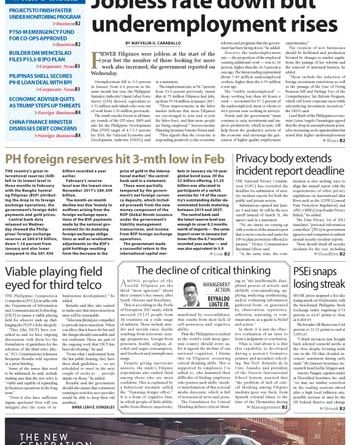BIZ-EMPLOYMENT: MANILA – Jobless rate down but underemployment rises
Unemployment fell to 5.3 percent in January from 6.6 percent in the same month last year, the Philippine Statistics Authority’s latest Labor Force Survey (LFS) showed, equivalent to 2.32 million individuals who were out of work from 2.76 million previously.
The result was the lowest in all January rounds of the LFS since 2009 and also hit the Philippine Development Plan (PDP) target of 4.7-5.3 percent for 2018, the National Economic and Development Authority (NEDA) said in a statement.
The employment rate, at 94.7 percent from 93.4 percent previously, meant that 41.75 million Filipinos had jobs, up from 39.34 million in January 2017.
“These improvements in the labor market indicate that more Filipinos are encouraged to join and re-join the labor force, and that more people are being employed,” Socioeconomic Planning Secretary Ernesto Pernia said.
“This signals that the economy is responding positively to the economic reforms and programs that the government has been laying down,” he added.
However, the underemployment rate — the proportion of the employed wanting additional work — rose to 18 percent, higher than the 16.3 percent a year ago. The latest reading represented about 7.49 million underemployed workers, higher than the 6.39 million a year ago.
The “visibly underemployed” — those working less than 40 hours a week — accounted for 57.1 percent of the underemployed, most or whom or 44.6 percent were working in services.
Pernia said the government “must continue to raise investments and improve productivity, which in turn, will help boost the productive sectors of the economy and encourage the generation of higher quality employment opportunities.”
The creation of new businesses should be facilitated and production boosted by changes to market regulations, the passage of key reforms and the removal of structural barriers, he added.
“These include the reduction of foreign investment restrictions as well as the passage of the Ease of Doing Business bill and Package Two of the Comprehensive Tax Reform Program, which will lower corporate taxes while rationalizing investment incentives,” the NEDA said.
Land Bank of the Philippines economist Guian Angelo Dumalagan agreed that the drop in unemployment pointed to increasing work opportunities but noted that higher underemployment suggested some weakness in the quality of jobs being created.
“Moving forward, labor figures are expected to improve, as the government’s tax reform and infrastructure programs could open up more job opportunities for everyone,” he said.
The NEDA, meanwhile, also highlighted that the labor force participation rate (LFPR) had increased by 1.5 percentage points to 62.2 percent in January, with the female LFPR rising by 2.3 percentage points to 47.5 percent.
“This reflects the sharp decline in the number of economically inactive married women and females who opt out of the labor force due to household duties,” the agency said.
Services remained the top employment contributor with a 55.9-percent share, followed by agriculture (26 percent) and industry (18.1 percent).
Pernia emphasized a need to help move agriculture workers out of low-productivity jobs, calling for a shift to high-value crops, crop diversification and the development of farm to market roads.
He expressed optimism that opportunities in the industry sector would increase, saying “more jobs are expected to be created during the country’s infrastructure build up which will not only ease traffic and promote regional development but also generate more quality jobs.”
Youth unemployment, meanwhile, slid to 12.5 percent in January, the lowest rate recorded for January since 2009. Also, the share of inactive youth — those who are neither studying nor employed — also declined to 18.8 percent.
“If we are to sustain this trend for the rest of the year, we can achieve the PDP target of lowering youth unemployment to 19.5 – 21.5 percent for 2018,” Pernia said.
“It is important that we continue to push for the full implementation of the Responsible Parenthood and Reproductive Health Law to enable more women to participate in the labor force,” he said.
He added that it may be the appropriate time to establish a legal and regulatory framework that will allow part-time work, especially in low-paying jobs.
“This will especially benefit school dropouts so they can study or be trained further and get themselves into higher paying jobs in the future.” / Manila Times Business / BY MAYVELIN U. CARABALLO, TMT ON
.
NOTE : All photographs, news, editorials, opinions, information, data, others have been taken from the Internet ..aseanews.net | [email protected] | For comments, Email to : Pahulu Gan – Contributor | [email protected]









